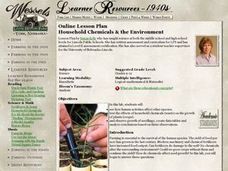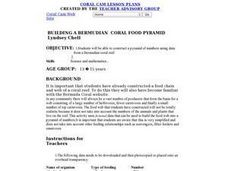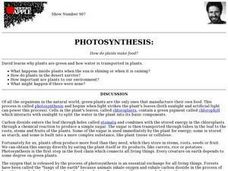Curated OER
The Environment and Interactions of Living Organisms
Students study the environment and interactions of living organisms. They identify abiotic and biotic factors and create a foldable and vocabulary cards. They create a poster illustrating soil and watch a video to study symbiosis.
Curated OER
Seabird Survival Adaptation Card Game
Students study seabirds and how they have adapted to their environments. For this activity based lesson students will play a card game that will allow them to have a better understanding of seabirds and their adaptations.
Curated OER
Fungus
Students study fungus, its reproduction and uses. In this eukaryote lesson students complete several fungal experiments.
Curated OER
Whale Adaptations
Students explore whales and how they have adapted to survive in the ocean. In this whale adaptations lesson students complete several activities that allow them to investigate animal adaptations.
Curated OER
The Electric Sieve
Learners examine different mixtures and how they can be separated. In this electric sieve lesson students complete an activity that allows them to separate mixtures.
Curated OER
Breakfast for Champions
Students prepare an event to honor philanthropic activities in their community. In this common good lesson plan, students send out invitations to local non-profits or to those who engage in philanthropic activities and plan an awards...
Curated OER
Energy Flow - How Much Biomass do Plants Produce?
Young scholars explore the concept of biomass. In this plant lesson, students conduct a scientific investigation that requires them to observe plant growth and biomass.
Curated OER
Symbiotic Relationships
Seventh graders research types of symbiotic relationships on the Internet and explain what the effects would be in one of the species disappears. For this investigative lesson students use the Internet to do research then...
Curated OER
Diet: Soup and Salad Lab
Students prepare soup and salad meals and assess their nutritional and aesthetic values. After solving soup riddles and discussing types of salads, they use meal planning forms to list ingredients and recipe information. The lesson plan...
Curated OER
Household Chemicals & the Environment
Students conduct a laboratory experiment designed to investigate the effects of chemicals, soil quality and pollution on seed growth and plant yield. They consider how best to maximize agriculture in the long term.
Curated OER
Marine & Aquatic Habitats Activities - Habitats of Birds, Fish, and Mammals on the Island and the Pacific Region
Young scholars create habitats in jars to understand integral aspects of plants' and animals' habitats.
Curated OER
My Biotic Creation
Eighth graders explore different ecosystems. In this ecosystem survival lesson conditions lesson students create their own fictional creature.
Curated OER
Getting a Handle on Your Bee
Students observe dried bees, carefully glue them to toothpicks, and use them for cross pollinating their Brassica plants. They also describe reasons why two similar investigations can produce different results. Finally, students...
Curated OER
Climate and Temperature
Students explore what the soil temperature would be on the north and south sides of a building. For this temperature lesson, students hypothesize what the results will be using a thermometer and then after a week see what the...
Curated OER
Antarctica
Students explore why Antarctica is so important to the planet. They investigate the physical characteristics. Students create their own unique treaty of governance for Antarctica and discuss how laws are enforced in Antarctica.
Curated OER
Let's Make a Tubeworm!
Students discuss deep-sea chemosynthetic communities then create a poster of a three-dimensional tubeworm. In this creative lesson students create their own tubeworm and write a written report on it.
Curated OER
Ecosystems
Students work in small groups to create a poster illustrating the flow of energy through a typical ecosystem, then present their posters to the class.
Curated OER
Population Density
Students use the scientific method to conduct an experiment and use varied methods to gather background information. They correctly use lab equipment and prepare tables and graphs that organize, conclude, and present their findings. ...
Curated OER
The Akron Global Polymer Academy Lesson Plan Format
Students identify types of garbage that will decompose quickly and the ones that do not. In this decomposing instructional activity students observe and record the photo degrading of six pack rings.
Curated OER
Critters in the Classroom
Students investigate with sea urchins. In this ocean habitat lesson, students observe sea urchins and other ocean grazers. Students work with lab equipment to examine the anatomy of these creatures.
Curated OER
Volunteering Our Time
Students participate in a service learning project. In this philanthropy lesson, students volunteer their time at a local soup kitchen and reflect upon the experience in a journal.
Curated OER
Science: Coral Reef Food Pyramid
Learners construct numbers pyramids using fictional data from a coral reef. they tally the numbers of carnivores, herbivores, and producers. Students next build a pyramid shape in which they put their numbers of producers, herbivores,...
Curated OER
Global Health: Hunger and Food Around the Globe
Students discuss hunger around the world and come up with a service project. In this global hunger lesson, students define vocabulary words and discuss service projects. Students derive a plan, carry it out, and reflect on the process of...
Curated OER
Photosynthesis: How do plants make food?
Students study why plants are green and how water is transported in them. They examine how plants respond to different amounts of light.
Other popular searches
- Con Pair Organic Foods
- Organic Foods Taste
- Non Organic Foods
- Com Pair Organic Foods
- California Organic Foods
- Compair Organic Foods
- Conpair Organic Foods
- Organic Foods Lesson Plan























